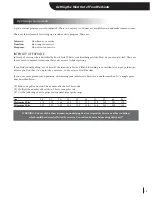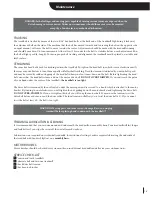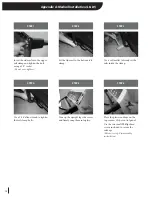
13
Getting the Most Out of Your Workouts
Walkers:
Walk a minimum of 40 to 60 minutes each workout.
Runners:
Run 15 to 40 minutes each workout. If you run more than 40 minutes, be sure that you also strengthen your leg
and hip muscles with resistance exercise.
DURATION OF EXERCISE
Walkers:
Walk every day.
Runners:
Run three to five times per week.
BEFORE YOU WORK OUT
• Never overdress; you may overheat. Wear loose-fitting clothes that do not rub or chafe.
• Think about your workout briefly before you begin. Remind yourself about the benefits you’ll receive, about the
commitment you’ve made to your health, and how good you’ll feel afterwards.
• Start SLOWLY, work up to the intensity you like gradually. Take at least five minutes to reach peak intensity.
DURING YOUR WORKOUT
• Stay in the middle portion of the treadbelt.
• Monitor your breathing. Can you carry on a normal conversation or are you out of breath? If you use the heart rate
method of monitoring intensity, are you within the heart rate zone?
• Change the speed and incline as needed to stay within the breathing and heart rate criteria.
TIP:
If you want to simulate outdoor conditions for walking or running on a level surface, set the treadmill incline to 2%.
This also helps to further cushion the impact of your feet on the moving surface.
AFTER YOUR WORKOUT
• Drink a large glass of water (you’ll recover faster).
• Congratulate yourself for completing the workout.
• Do some light stretching exercises.
• Record that you completed the workout on your calendar.
KEEPING TRACK OF PROGRESS
• Keep a calendar that shows scheduled and actual workouts.
• Record every workout you complete.
• Compare planned with actual workouts completed. Aim for 90% completion. If you’re averaging less than 90%, reevaluate
your schedule and examine why you’re missing 10% of your workouts (and the extra benefits from those missing workouts).
• Check in occasionally with your doctor and discuss your progress. It’s good motivation and you’ll pick up some tips.
Or give some now that you’re an expert!
CALORIE COMPUTATIONS
• Calories and calories/hour are calculated using the formulas developed by the American College of Sports Medicine. There
are two different equations. One is for walking and one for running. The American College of Sports Medicine uses the
walking equation for speeds less than or equal to 3.7 mph. The running equations are used for speeds in excess of 3.8 mph.
• The computations are based on a 150-pound person, which is a close enough estimate for most people. If you wish the
equations to be more precise, however, you may enter your weight into the treadmill.
See
“Getting Started”
for steps to enter your exact weight into the treadmill.
Summary of Contents for Pro Sports Trainer
Page 23: ......





































